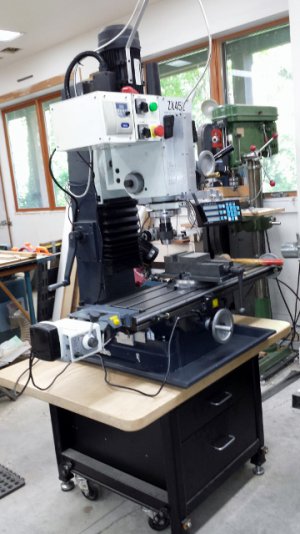I have a ZAY-7045F/G which is as I believe to be an RF-45 clone.
It has a 2HP single phase twin capacitor motor that is wired for 220V.
Here's the issue. Intermittently it will get stuck in "start". Upon starting the motor from stopped, it will make a screeching howling like sound. If I turn it off, and back on, usually this will solve the issue and it will start as normal. Now, one time, this happened, and it would not go away. So I took the motor off the machine and disassembled it to find that the contacts on the centrifugal start switch inside the motor had "welded" together. They spung apart easily, and I filed them clean and that solved the issue of it being permanently stuck, but it still intermittently sticks on startup.
So my question is, how can I remedy this? It seems fixable, i'm just missing the trick. I'm attributing it to a cheaper chicom motor and even cheaper parts being used inside. But maybe I'm wrong. I was wondering about something like dielectric grease on the contact maybe? But really, what would help here I think is to understand what is causing the issue of "welding" the contacts and then moving forward from there. This really makes using the mill a bit of a hassle at times, and I don't want it to stick permanently like it did before while I'm in the middle of a project again.
So here I am reaching out to those more knowledgeable with electric components for advice.
Thanks in advance.
It has a 2HP single phase twin capacitor motor that is wired for 220V.
Here's the issue. Intermittently it will get stuck in "start". Upon starting the motor from stopped, it will make a screeching howling like sound. If I turn it off, and back on, usually this will solve the issue and it will start as normal. Now, one time, this happened, and it would not go away. So I took the motor off the machine and disassembled it to find that the contacts on the centrifugal start switch inside the motor had "welded" together. They spung apart easily, and I filed them clean and that solved the issue of it being permanently stuck, but it still intermittently sticks on startup.
So my question is, how can I remedy this? It seems fixable, i'm just missing the trick. I'm attributing it to a cheaper chicom motor and even cheaper parts being used inside. But maybe I'm wrong. I was wondering about something like dielectric grease on the contact maybe? But really, what would help here I think is to understand what is causing the issue of "welding" the contacts and then moving forward from there. This really makes using the mill a bit of a hassle at times, and I don't want it to stick permanently like it did before while I'm in the middle of a project again.
So here I am reaching out to those more knowledgeable with electric components for advice.
Thanks in advance.


